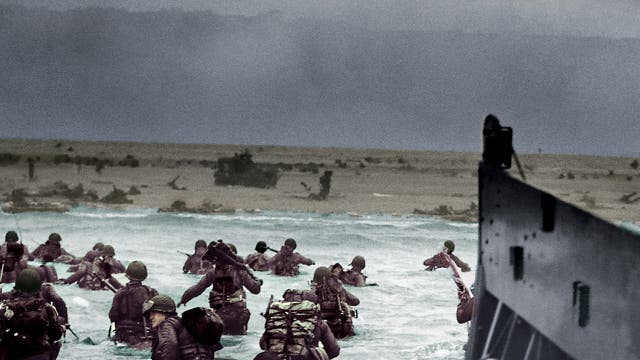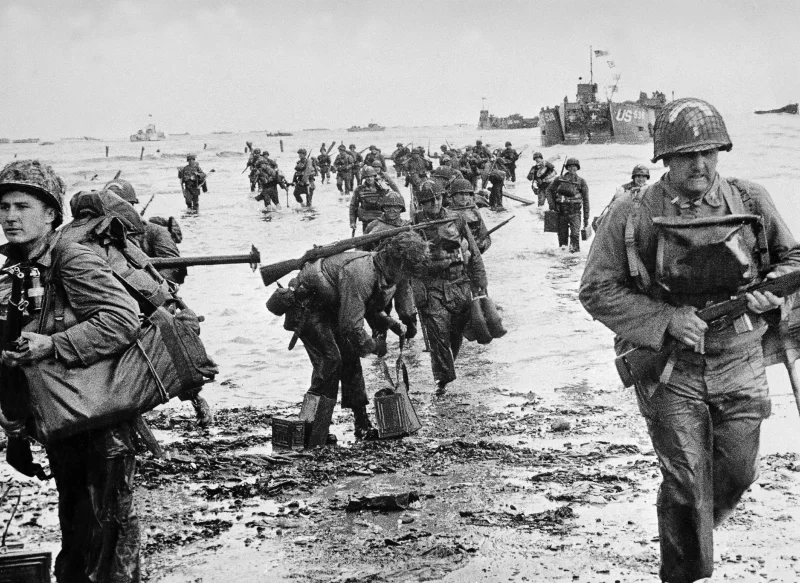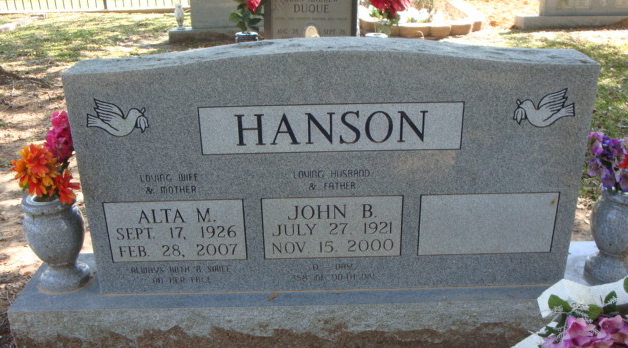![]()
By Tracy Gupton and Ben Tumlinson
Columbia Historical Museum
It was the largest amphibious invasion in the history of warfare. More than 156,000 brave young soldiers from the United States, the United Kingdom and Canada stormed the nearly 50 miles of beaches of Normandy in northern France in a bold strategy to push the Nazis out of Western Europe and turn the tide of World War II for good.
Today marks the 79th anniversary of D-Day, which occurred on June 6, 1944. It was bloody and chaotic but by the end of that day the Allied Forces had taken all five Normandy beaches by nightfall. In planning the D-Day attack, Allied military leaders knew that casualties might be staggeringly high, but it was a cost they were willing to pay in order to establish an infantry stronghold in France.
John B. Hanson of West Columbia was one of the lucky ones. He made it back home alive. To the current day the number of dead, wounded, missing and captured remains unclear. But in cities and towns across this great nation, even little towns like West Columbia, everyone should take a moment of gratitude and pause long enough to say thank you to those thousands of brave men who risked their lives on D-Day. The Allied soldiers’ eventual success in battle at Normandy on June 6, 1944, played a major role in Germany’s defeat in World War II.

Photo By Robert F. Sargent/Chief Photographer’s Mate
“Into the Jaws of Death” is the title of this historic photograph of Allied soldiers storming the beaches of northern France at Normandy on June 6, 1944, as part of Operation Neptune on D-Day, which occurred 79 years ago today.
The average age of those young men who participated in the D-Day invasion of Germany-held northern France was 22, the same age West Columbia’s John B. Hanson was on that memorable day in 20th Century world history.
D-Day veteran Frank DeVita was barely 19 when he was involved in storming Omaha Beach at Normandy. The amphibious vessel DeVita was riding in was packed with young soldiers such as himself, hearts racing, adrenaline pounding through their veins. Like Hanson, DeVita survived to tell horrific stories about what he witnessed.
“This was our shield,” DeVita said of the steel ramp that was raised when their boat approached the shore at Omaha Beach, “As long as it was up. And as we approached the shoreline where the water hits the sand, and the (German) machine guns were hitting the front of the boat – it was like a typewriter.” DeVita was ordered to drop the ramp but he hesitated, knowing what was about to occur if he did so. He eventually followed orders. “I dropped the ramp and the first seven, eight, nine, ten guys went down like you were cutting down wheat … they were kids!”

Columbia Historical Museum Board Member Ben Tumlinson of Columbia Lakes, a recently retired U.S. Army veteran himself, wrote in this column last year about the heroics of John B. Hanson of West Columbia alongside so very many other brave soldiers on the Normandy beaches of northern France 79 years ago.
“On Easter Sunday (1944), Hanson arrived at Liverpool Harbor, England,” Tumlinson’s D-Day story from 2022 stated. “Upon their arrival, training began again. In May, the units would move once again, this time to camps near Newport, Wales. On June 4, 1944, Hanson would have been busy making final preparations dockside and loading the liberty ships with equipment. This would be their final move before the launch of Operation Overlord and Neptune. Hanson was headed to Normandy.”
Hanson, whose family goes back to the early days of West Columbia’s history, was a member of the U.S. Army’s 358th Infantry Regiment’s B Company. Tumlinson wrote in last year’s D-Day story in this Columbia Historical Museum column that “Elements of the 90th Infantry Division were among the five Army divisions to assault the beaches on June 6, 1944. The remainder of the division followed suit on June 8th. Among the 90th Division’s 358th Infantry Regiment’s soldiers was one of West Columbia’s own, John B. Hanson.”

John B. Hanson of West Columbia (pictured standing, in center) photographed at Fort Dix, New Jersey, in 1944
According to the National Archives’ World War II Army Enlistment Records from 1938-1946, Private Hanson enlisted in the U.S. Army in Houston on March 11, 1942, at age 20. Tumlinson’s 2022 D-Day story said that John B. Hanson did his basic training at Camp Barkeley near Abilene, was trained in mechanized tactics in Louisiana, and by August, 1942, he found himself in the deserts of Arizona and California.
“Upon completion of that training, the regiment boarded trains and made their way to Fort Dix, New Jersey, on New Years Day 1944,” Tumlinson wrote. “In March, Hanson, the 358th, along with the rest of the 90th Infantry Division received orders for overseas duty in the European Theater of Operation.”
American newspapers were full of mind-boggling factoids and statistics about how D-Day had succeeded when the folks back home in the United States devoured the June 7, 1944, papers. “The U.S. people had wondered for weeks how they would behave on D-Day,” was reported in the June 12, 1944, issue of TIME magazine, the first edition of America’s favorite weekly magazine to be published since Operation Overlord (the name of the Allies’ large-scale invasion of France) and Operation Neptune (the amphibious assault) had been successful. “When it came, they went about their regular business. Race tracks called off their programs for the day; many stores closed at noon. The citizens stuck to their radios, read newspaper extras as they rolled off the presses, sat and thought, stood and drank, knelt and prayed.”
“There was no sudden fear,” the TIME story continued, “as on that September morning in 1939 when the Germans marched into Poland; no sudden hate, as on Pearl Harbor day. This time, moved by a common impulse, the casual churchgoers as well as the devout went to pray.”
And pray is exactly what soldiers like John B. Hanson of West Columbia and the many, many others on both sides of the battle most likely did in abundance 79 years ago. In writing last year at this time about Hanson, Lt. Col. Ben Tumlinson said the ship Hanson was on “dropped anchor off Utah Beach on the Cherbourg Peninsula on June 8, 1944. Debarkation started at 11:58 that morning, and the crafts rammed up on the beach, the men unloaded and waded through waist-deep water to the dry sands and made their way inland.”

Born in West Columbia, Texas, in 1921, D-Day veteran John B. Hanson was laid to rest at Columbia Cemetery following his passing at his home in West Columbia on November 15, 2000, at the age of 79. His wife died in 2007.
Nineteen young men from Bedford, Virginia, all National Guardsmen, were among the first to die after landing on Omaha Beach June 6, 1944. Because of that extremely sad factoid, there is a National D-Day Memorial Foundation site in Bedford, Virginia, where there are 4,414 names enshrined in bronze plaques representing every Allied soldier, sailor, airman and coast guardsman who died on D-Day. The estimate of 4,414 fatalities includes 2,501 Americans. German casualties were estimated at between 4,000 and 9,000 killed, wounded or missing on D-Day. The Allies also captured some 200,000 German prisoners of war over those several days in June 79 years ago.
During World War II it is believed that 35 young men from Brazoria County, Texas, were killed in action, 18 died from non-battle injuries and another eight later died from their wounds in battle. While brave soldiers from the West Columbia area like John B. Hanson returned home to continue his life, others weren’t so lucky.
Hanson passed away at the age of 79 on November 15, 2000, and is buried beside his wife Alta M. Hanson at historic Columbia Cemetery in West Columbia. Tumlinson’s story about John B. Hanson from 2022 revealed that he went on to fight throughout northern France after D-Day until he was wounded in combat. He was awarded the Purple Heart and the Bronze Arrowhead for his valor and bravery at time of war.
